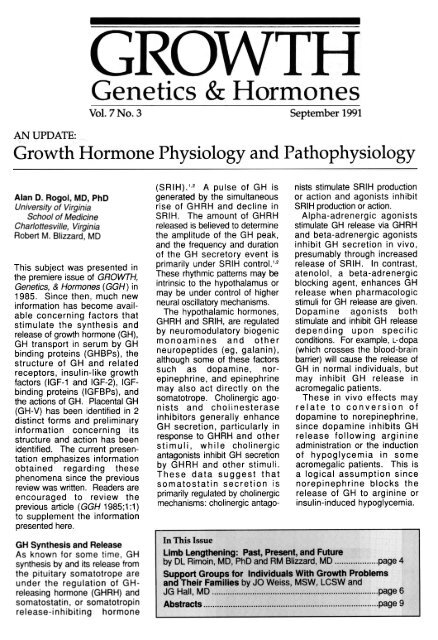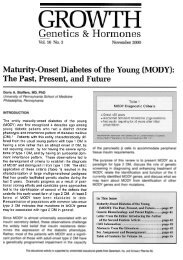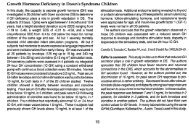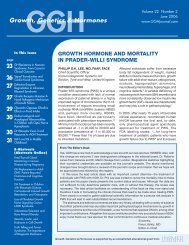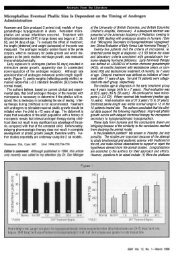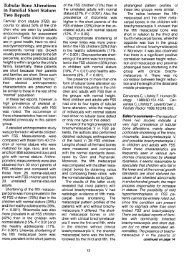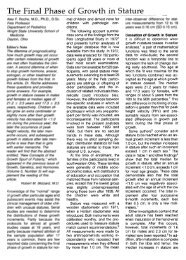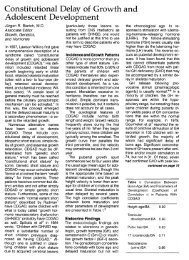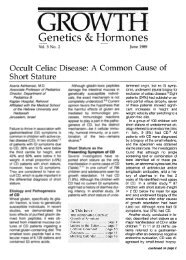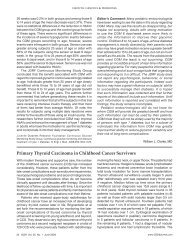an update: growth hormone physiology and ... - GGH Journal
an update: growth hormone physiology and ... - GGH Journal
an update: growth hormone physiology and ... - GGH Journal
Create successful ePaper yourself
Turn your PDF publications into a flip-book with our unique Google optimized e-Paper software.
Vol. 7 No. 3 September 1991<br />
Al<strong>an</strong> D. Rogal, MD, PhD<br />
University of Virginia<br />
School of Medicine<br />
Charlottesville, Virginia<br />
Robert M. Blizzard, MD<br />
This subject was presented in<br />
the premiere issue of GROWTH,<br />
Genetics, & Hormones (<strong>GGH</strong>) in<br />
1985. Since then, much new<br />
information has become available<br />
concerning factors that<br />
stimulate the synthesis <strong>an</strong>d<br />
release of <strong>growth</strong> <strong>hormone</strong> (GH),<br />
GH tr<strong>an</strong>sport in serum by GH<br />
binding proteins (GHBPs), the<br />
structure of GH <strong>an</strong>d related<br />
receptors, insulin-like <strong>growth</strong><br />
factors (IGF-1 <strong>an</strong>d IGF-2), IGFbinding<br />
proteins (IGFBPs), <strong>an</strong>d<br />
the actions of GH. Placental GH<br />
(GH-V) has been identified in 2<br />
distinct forms <strong>an</strong>d preliminary<br />
information concerning its<br />
structure <strong>an</strong>d action has been<br />
identified. The current presentation<br />
emphasizes information<br />
obtained regarding these<br />
phenomena since the previous<br />
review was written. Readers are<br />
encouraged to review the<br />
previous article (<strong>GGH</strong> 1985;1 :1)<br />
to supplement the information<br />
presented here.<br />
GH Synthesis <strong>an</strong>d Release<br />
As known for some time, GH<br />
synthesis by <strong>an</strong>d its release from<br />
the pituitary somatotrope are<br />
under the regulation of GHreleasing<br />
<strong>hormone</strong> (GHRH) <strong>an</strong>d<br />
somatostatin, or somatotropin<br />
release-inhibiting <strong>hormone</strong><br />
(SRIH).1,2 A pulse of GH is<br />
generated by the simult<strong>an</strong>eous<br />
rise of GHRH <strong>an</strong>d decline in<br />
SRIH. The amount of GHRH<br />
released is believed to determine<br />
the amplitude of the GH peak,<br />
<strong>an</strong>d the frequency <strong>an</strong>d duration<br />
of the GH secretory event is<br />
primarily under SRIH control.1,2<br />
These rhythmic patterns may be<br />
intrinsic to the hypothalamus or<br />
may be under control of higher<br />
neural oscillatory mech<strong>an</strong>isms.<br />
The hypothalamic <strong>hormone</strong>s,<br />
GHRH <strong>an</strong>d SRIH, are regulated<br />
by neuromodulatory biogenic<br />
monoamines <strong>an</strong>d other<br />
neuropeptides (eg, gal<strong>an</strong>in),<br />
although some of these factors<br />
such as dopamine, norepinephrine,<br />
<strong>an</strong>d epinephrine<br />
may also act directly on the<br />
somatotrope. Cholinergic agonists<br />
<strong>an</strong>d cholinesterase<br />
inhibitors generally enh<strong>an</strong>ce<br />
GH secretion, particularly in<br />
response to GHRH <strong>an</strong>d other<br />
stimuli, while cholinergic<br />
<strong>an</strong>tagonists inhibit GH secretion<br />
by GHRH <strong>an</strong>d other stimuli.<br />
These data suggest that<br />
somatostatin secretion is<br />
primarily regulated by cholinergic<br />
mech<strong>an</strong>isms: cholinergic <strong>an</strong>tago-<br />
nists stimulate SRIH production<br />
or action <strong>an</strong>d agonists inhibit<br />
SRIH production or action.<br />
Alpha-adrenergic agonists<br />
stimulate GH release via GHRH<br />
<strong>an</strong>d beta-adrenergic agonists<br />
inhibit GH secretion in vivo,<br />
presumably through increased<br />
release of SRIH. In contrast,<br />
atenolol, a beta-adrenergic<br />
blocking agent, enh<strong>an</strong>ces GH<br />
release when pharmacologic<br />
stimuli for GH release are given.<br />
Dopamine agonists both<br />
stimulate <strong>an</strong>d inhibit GH release<br />
depending upon specific<br />
conditions. For example, L-dopa<br />
(which crosses the blood-brain<br />
barrier) will cause the release of<br />
GH in normal individuals, but<br />
may inhibit GH release in<br />
acromegalic patients.<br />
These in vivo effects may<br />
relate to conversion of<br />
dopamine to norepinephrine,<br />
since dopamine inhibits GH<br />
release following arginine<br />
administration or the induction<br />
of hypoglycemia in some<br />
acromegalic patients. This is<br />
a logical assumption since<br />
norepinephrine blocks the<br />
release of GH to arginine or<br />
insulin-induced hypoglycemia.
Serotonin <strong>an</strong>d its precursors,<br />
tryptoph<strong>an</strong> <strong>an</strong>d 5-hydroxytryptoph<strong>an</strong>,<br />
also induce the<br />
release of GH in vivo, but the<br />
mech<strong>an</strong>ism is uncertain.<br />
Since 1985, 2 other stimuli have<br />
been described. A GH-releasing<br />
peptide (GHRP), a hexapeptide<br />
(h is- D-trp-ala -trp- D-phe-lys-<br />
NHJ,3,4 has been developed<br />
synthetically but is not<br />
homologous to the GHRH-related<br />
peptides of 40 or 44 amino acids.<br />
Its activity in hum<strong>an</strong>s is not<br />
diminished by SRIH <strong>an</strong>d its ability<br />
to cause the release of GH when<br />
submaximal amounts of GHRH<br />
are given is at least additive <strong>an</strong>d<br />
possibly synergistic. The role of<br />
this peptide or its native<br />
homologue, if such exists, has not<br />
yet been defined.<br />
Gal<strong>an</strong>ins,6 is a naturally<br />
occurring neuropeptide present<br />
in considerable amounts in the<br />
medi<strong>an</strong> eminence of the<br />
hypothalamus. It causes GH<br />
release under appropriate<br />
conditions; however, its physiologic<br />
role is poorly understood.<br />
In hum<strong>an</strong>s, the administration of<br />
porcine gal<strong>an</strong>in is followed by<br />
GH release, <strong>an</strong>d it enh<strong>an</strong>ces by<br />
3-fold the GH release in<br />
response to GHRH.S Its effect is<br />
thought to be indirectly mediated<br />
by epinephrine acting on GHRH<br />
neurons. Gal<strong>an</strong>in is considered<br />
to control pulsatile GH secretion<br />
by decreasing somatostatin<br />
inhibitory tone.6,? Neither GHRP<br />
nor gal<strong>an</strong>in appears at this time<br />
to be as import<strong>an</strong>t as GHRH in<br />
producing GH release, although<br />
the presence of gal<strong>an</strong>in in the<br />
medi<strong>an</strong> eminence suggests <strong>an</strong><br />
innate biologic function.<br />
Other aspects of GH secretion<br />
that have been clarified in the<br />
past 6 years include the effects of<br />
estrogen <strong>an</strong>d testosterone. At<br />
even very low doses of gonadal<br />
steroid <strong>hormone</strong>s, the qu<strong>an</strong>tity of<br />
GH secreted over a 24-hour<br />
period is increased by 2 to 3 times<br />
the amount secreted in their<br />
absence. These increases occur<br />
as a result of <strong>an</strong> increase in the<br />
pulse amplitude of the GH<br />
secretory episodes <strong>an</strong>d not by<br />
increasing the frequency of peaks<br />
(approximately 7 or 8 per day) in<br />
both the prepubertal <strong>an</strong>d pubertal<br />
periods.8 Also included in new<br />
information is the observation<br />
reported recently by Martha <strong>an</strong>d<br />
coworkers9 <strong>an</strong>d Veldhuis <strong>an</strong>d<br />
colieagues1O that GH secretion is<br />
inversely related to body mass<br />
index (wVht2). This observation<br />
may provide one expl<strong>an</strong>ation for<br />
extremes of GH secretion among<br />
normal individuals who, except<br />
for differences in body mass<br />
index, are indistinguishable.<br />
GH Tr<strong>an</strong>sport in Serum<br />
GH is tr<strong>an</strong>sported in serum<br />
attached to binding proteins; the<br />
major one of which is closely<br />
related to the GH receptor.11<br />
This binding protein is identical<br />
to the extracellular domain of the<br />
receptor, <strong>an</strong>d appears to be<br />
generated either by alternative<br />
splicing of the receptor mANA<br />
with direct extrusion of the<br />
protein into serum or by a<br />
trypsin-like cleavage of the<br />
extracellular component of the<br />
receptor in vivo. Approximately<br />
45% of circulating GH is bound<br />
to this high affinity protein, <strong>an</strong>d<br />
5% is bound to a low affinity<br />
GHBP of 100 kd molecular<br />
weight. Approximately 50% of<br />
the GH remains unbound, or<br />
"free." Circulating levels of<br />
GHBP are low in the fetus <strong>an</strong>d<br />
newborn, but increase over time,<br />
especially during the pubertal<br />
<strong>growth</strong> spurt. GHBPS11 <strong>an</strong>d the<br />
GH receptors12 are absent as a<br />
result of partial gene deletion13 in<br />
children with GH insensitivity<br />
(Laron type dwarfism) who have<br />
a GHD-like phenotype <strong>an</strong>d fail to<br />
respond to GH administration.<br />
The exact roles of these binding<br />
proteins are unknown, but<br />
they may decrease the rate of<br />
degradation of GH or modify<br />
the availability of GH in some<br />
other way.<br />
GH Receptor <strong>an</strong>d Related<br />
Receptors<br />
The GH receptor is a member of a<br />
family of 3 related straight-chain<br />
polypeptides with specificity<br />
toward GH (somatogenic),<br />
prolactin (lactogenic), <strong>an</strong>d<br />
chorionic somatomammotropin or<br />
placental lactogen. The clinical<br />
signific<strong>an</strong>ce of the ability of GH to<br />
affect the prolactin receptor <strong>an</strong>d<br />
prolactin to act at the somatogenic<br />
receptor is not known. Some<br />
patients with acromegaly (approximately<br />
25% to 50%) will have mild<br />
hyperprolactinemia, but only a<br />
small percentage will have<br />
galactorrhea. Whether this<br />
biologic effect is due to GH acting<br />
at the lactogenic receptor, due to<br />
prolactin itself, or due to some<br />
other mech<strong>an</strong>ism has not yet been<br />
determined. Other members of<br />
the superfamily include receptors<br />
for some of the interleukins,<br />
gr<strong>an</strong>ulocyte-macrophage colonystimulating<br />
factor, <strong>an</strong>d erythropoietin.<br />
All are single-chain<br />
glycoproteins with homology in a<br />
210 amino-acid sequence with the<br />
extracellular, lig<strong>an</strong>d-binding region<br />
of the amino terminus. This<br />
segment is attached to a variable<br />
length intracellular component of<br />
the receptor by a highly<br />
homologous tr<strong>an</strong>smembr<strong>an</strong>e<br />
segment of 22 amino acids.<br />
IGF <strong>an</strong>d IGFBPs<br />
IGF <strong>an</strong>d IGFBPs are closely<br />
associated. Both IGF-1<br />
(somatomedin C) <strong>an</strong>d IGFBP-3,<br />
the major BP for IGF-1, increase<br />
with increasing GH production<br />
<strong>an</strong>d fall with decreasing GH<br />
production. Recent data14<br />
indicate that IGFBP-3 controls<br />
the bioavailability of IGF-1 <strong>an</strong>d<br />
IGF-2. Therefore, IGFBP-3<br />
appears to control the action of<br />
IGF-1 as well as GH secretion.<br />
These BPs, which now number<br />
at least 6, may be classified on<br />
the basis of (1) the amino-acid<br />
sequences, (2) molecular weight,<br />
or (3) immunoreactivity. Three of<br />
these are shown in Table 1.<br />
IGFBP-3, the acid-stable component<br />
of the 150 kd complex,<br />
probably is a major factor in<br />
<strong>growth</strong> regulation <strong>an</strong>d GH<br />
secretion. It is glycosylated <strong>an</strong>d<br />
consists of a 53 kd <strong>an</strong>d a 47 kd<br />
component. Serum levels are<br />
high in the fetus, but drop shortly
after birth <strong>an</strong>d then increase<br />
slowly until late prepuberty or<br />
very early puberty, at which time<br />
the values subsequently<br />
increase approximately 3-fold.<br />
IGF-1 levels increase concomit<strong>an</strong>tly,<br />
as does the qu<strong>an</strong>tity of GH<br />
secreted with each secretory<br />
episode in adolescent boys at<br />
T<strong>an</strong>ner stage III or IV of pubertal<br />
development.8 Peak values<br />
occur earlier in pubertal females.<br />
The levels of IGF-1 <strong>an</strong>d IGFBP-3<br />
are high in GH hypersecretory<br />
states, eg, acromegaly. The role<br />
of IGFBP-3 in respect to IGF-1<br />
remains to be elucidated. From<br />
the clinical aspect, however, it is<br />
now abund<strong>an</strong>tly clear that acid<br />
extraction of IGF-1 from its<br />
binding protein <strong>an</strong>d measurement<br />
of the result<strong>an</strong>t IGF-1 more<br />
clearly reflects the <strong>growth</strong>promoting<br />
effect th<strong>an</strong><br />
measurement of the IGF-1<br />
concentrations using the<br />
nonextracted procedure.<br />
IGFBP-1 is generally independent<br />
of GH, is found normally<br />
in amniotic fluid (placental<br />
source), is high in fetal blood,<br />
<strong>an</strong>d declines immediately after<br />
birth <strong>an</strong>d falls further throughout<br />
inf<strong>an</strong>cy, childhood, <strong>an</strong>d<br />
adolescence. Since IGFBP-1<br />
<strong>an</strong>d IGFBP-2 are GHindependent,<br />
<strong>an</strong>d because their<br />
function may be minimal in<br />
respect to <strong>growth</strong>, they are not<br />
considered further.<br />
GH <strong>an</strong>d IGF-1 Actions<br />
GH, IGF-1, <strong>an</strong>d other <strong>growth</strong><br />
factors work together to promote<br />
cartilage <strong>an</strong>d bone <strong>growth</strong>, as<br />
described separately in <strong>GGH</strong><br />
1990;6:2 by Horton <strong>an</strong>d by<br />
Moh<strong>an</strong>. M<strong>an</strong>y factors have been<br />
shown to influence 1 or more<br />
aspects of this scheme through<br />
endocrine, paracrine, <strong>an</strong>d<br />
possibly autocrine mech<strong>an</strong>isms.<br />
GH has a dual effect of<br />
epiphyseal cartilage <strong>growth</strong> <strong>an</strong>d<br />
differentiation of cartilage cells as<br />
well as generation of IGF-1.1s.16<br />
The proximal zone, close to the<br />
bony epiphysis, consists of a<br />
narrow b<strong>an</strong>d of germinal or stem<br />
cell chondrocytes. GH<br />
preferentially stimulates<br />
differentiation of these prechondrocytes<br />
while IGF-1<br />
stimulates the clonal exp<strong>an</strong>sion<br />
of the more differentiated cells<br />
in the distal proliferative zones.<br />
The demonstration by Walker<br />
et al17 that IGF-1 produces both<br />
positive nitrogen bal<strong>an</strong>ce <strong>an</strong>d<br />
hypercalciuria in patients with<br />
absent GH receptors indicates<br />
that GH itself is not necessary<br />
for the metabolic actions of GH<br />
except to generate IGF-1, but<br />
does not exclude the need for<br />
GH to promote chondrogenesis.<br />
New data also have accumulated<br />
concerning the complex<br />
pathway of direct GH action to<br />
generate protein synthesis <strong>an</strong>d<br />
<strong>growth</strong>. Three messengers or<br />
messenger systems appear to be<br />
involved in at least certain cell<br />
systems. GH is the first messenger,<br />
<strong>an</strong>d by binding to its receptor,<br />
activates the second messenger<br />
system, diacylglycerol <strong>an</strong>d protein<br />
kinase C. The oncogene, C-fOS,18<br />
may playa role as a nuclear switch<br />
or as a third messenger in some<br />
signal tr<strong>an</strong>sducing systems to<br />
activate tr<strong>an</strong>scription of appropriate<br />
genes to influence the biologic<br />
pathway of GH action.<br />
Placental GH (GH-V)<br />
Since 1985, several investigators<br />
have determined the<br />
structure <strong>an</strong>d role of "placental"<br />
GH, the natural product of the<br />
GH-V (GH vari<strong>an</strong>t) gene. This<br />
protein is expressed primarily by<br />
the placenta.'9 Daughaday <strong>an</strong>d<br />
coileagues2O have demonstrated<br />
large qu<strong>an</strong>tities of this GH<br />
vari<strong>an</strong>t (20 to 30 times the me<strong>an</strong><br />
GH level of nonpregn<strong>an</strong>t<br />
women) late in pregn<strong>an</strong>cy at a<br />
time when essentially no pituitary<br />
GH was demonstrable. IGF-1<br />
levels do not increase into the<br />
acromegalic level during<br />
pregn<strong>an</strong>cy, reflecting either<br />
inhibitors of IGF-1 generation by<br />
the large amounts of estrogen or<br />
failure of the GH-V to activate<br />
the second messenger<br />
system(s), despite the known<br />
effect of GH-V binding to the<br />
somatogenic receptor.<br />
Two distinct species (hGH-V<br />
<strong>an</strong>d hGH-V2) are synthesized by<br />
the placenta.21 The first is a 22 kd<br />
<strong>an</strong>d the second a 26 kd protein.<br />
The hGH-V2 protein differs from<br />
the hGH-V protein in the location<br />
of its intramolecular disulfide<br />
bonds. The hGH-V2 protein is<br />
secreted by the syncytiotrophoblast.<br />
The configuration of<br />
residues suggests that this hGH<br />
vari<strong>an</strong>t may be <strong>an</strong> integral<br />
membr<strong>an</strong>e protein. hGH-V2<br />
constitutes one third or more<br />
of total hGH-V mANA.<br />
Interestingly, the predomin<strong>an</strong>t<br />
hGH-V or 22 kd placental protein<br />
differs by only 13 amino acids<br />
from the 22 kd pituitary hGH-N<br />
gene product.<br />
Macleod et al22 demonstrated<br />
that the hGH-V vari<strong>an</strong>t is a<br />
biologically active somatogen<br />
<strong>an</strong>d lactogen. hGH-V binds<br />
efficiently to both somatogenic<br />
<strong>an</strong>d lactogenic receptors, but<br />
with a 7.4-fold greater specificity<br />
for the somatogenic receptor<br />
th<strong>an</strong> does hGH-N. Both hGH-V<br />
<strong>an</strong>d hGH-N produced similar<br />
weight gain at similar doses in<br />
hypophysectomized rats, but the<br />
mitotic response of the lactogeninducible<br />
Nb2 cells was signific<strong>an</strong>tly<br />
less for hGH-V. The<br />
comparable somatogenic, but<br />
lower lactogenic, bioactivity of<br />
hGH-V relative to hGH-N<br />
parallels the receptor binding<br />
profiles of the 2 <strong>hormone</strong>s <strong>an</strong>d<br />
suggests hGH-V has the<br />
potential to perform a unique role<br />
during hum<strong>an</strong> gestation.23<br />
Summary<br />
GH appears to be even more<br />
import<strong>an</strong>t <strong>an</strong>d more complex in<br />
its physiologic actions th<strong>an</strong> was<br />
imagined in 1984 when the first<br />
review of this topic was written<br />
for the premiere issue of <strong>GGH</strong>.<br />
GHRH as a potential therapeutic<br />
agent has been<br />
temporarily shelved awaiting a<br />
depot formulation. GHRP <strong>an</strong>d<br />
gal<strong>an</strong>in have been recognized<br />
<strong>an</strong>d continue to be studied<br />
although their direct therapeutic<br />
role c<strong>an</strong> only be speculated.<br />
The binding proteins for GH <strong>an</strong>d
the IGFs are now recognized as<br />
potent players in the physiologic<br />
References<br />
1. T<strong>an</strong>nenbaum GS, et al.<br />
arena of GH <strong>an</strong>d IGF action.<br />
Endocrinology 1984;115:1952-<br />
IGF-1 is <strong>an</strong> effective therapeutic<br />
1957.<br />
agent in patients who have 2. Plotsky PM, et al. Science<br />
absent receptors for GH.<br />
1985;230:461-463.<br />
Possibly of equal import<strong>an</strong>ce, a 3. Bowers CY, et al. Endocrinology<br />
new GH regulatory system of 1984;114:1537-1545.<br />
the placental-fetal unit has been 4. IIson BE, et al. J Clin Endocrinol<br />
recognized <strong>an</strong>d is being<br />
Metab 1989;69:212-214.<br />
studied.<br />
We never <strong>an</strong>ticipated in 1984<br />
5. Davis RG, et al. Endocrinology<br />
1987;120:1658-1662.<br />
when the previous article was 6. Maiter OM, et al. Endocrinology<br />
written that so much would be<br />
1990;126:1216-1222.<br />
learned in the short period of 7years. 7.<br />
We <strong>an</strong>xiously await the<br />
Loche S, et al.<br />
1990;27:405-407.<br />
Pediatr Res<br />
passage of <strong>an</strong>other 7 yearswhen, 8. Martha PM Jr, et al. J Clin<br />
hopefully, we will have<br />
Endocrinol Metab 1989;69:563-<br />
the opportunity to <strong>update</strong> you<br />
570.<br />
regarding GH <strong>physiology</strong> <strong>an</strong>d 9. Martha PM Jr, et al. J Clin<br />
patho<strong>physiology</strong> in volume 14<br />
Endocrinol Metab 1990;73:197-<br />
of GROWTH, Genetics, &<br />
202.<br />
Hormones.<br />
10. Veldhuis JD, et al. J Clin<br />
Endocrinol Metab 1991 ;73:197-<br />
202.<br />
11. Baum<strong>an</strong>n G. Trends Endocrinol<br />
Metab 1990;1 :342-347.<br />
12. Eshet R, et al. Isr J Med Sci<br />
1984;20:8-11.<br />
13. Godowski PJ, et al. Proc Natl Acad<br />
sa USA 1989;86:8083-8087.<br />
14. Hardouin S, et al. J Clin<br />
Endorcinol Metab 1989;69:<br />
1291-1301.<br />
15. Isaacson OGP, et al. In Bercu BB,<br />
ed. Basic <strong>an</strong>d Clinical Aspects of<br />
Growth Hormone. New York, NY:<br />
Plenum Press; 1988:199-211.<br />
16. Hochberg Z. Growth <strong>an</strong>d<br />
Growth Factors 1990;5:127.<br />
17. Walker Jl, et al. N Engl J Med<br />
1991 ;324:1482-1489.<br />
18. Gurl<strong>an</strong>d G, et al. Endocrinology<br />
1990;127:3187-3195.<br />
19. Fr<strong>an</strong>kenne F, et al. J Clin<br />
Endocrinol Metab 1987;64:635-637.<br />
20. Daughaday WH, et al. J Clin<br />
Endocrinol Metab 1990;70:215-221.<br />
21. Cooke NE, et al. J Clin Invest<br />
1987;8211 :270-275.<br />
22. Macleod IN, et al. Endocrinology<br />
1991 ;128:1298-1302.<br />
23. Ray J, et al. J Bioi Chem<br />
1990;265:7939-7944.


